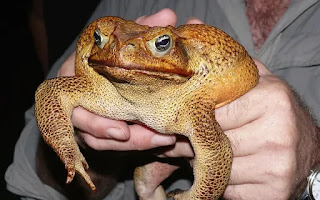Cane toads are a pest in Australia. They were introduced to kill beetles attacking sugar cane. Unfortunately, they were not interested in the beetle. They ate just about everything else. Native species have been greatly depopulated. Now, their DNA has been sequences. Furthermore, three viruses that destroy only cane toads have been identified.
virus discovery offers means controlling queensland's cane toad virus discovery offers means controlling queensland's cane toad skip sections navigation skip content skip footer network log open menu brisbane times brisbane times close search site sections network home brisbane queensland politics hide subsections federal queensland nsw victoria act western australia business show subsections economy markets companies banking finance business consumer affairs workplace world show subsections north america europe asia middle east oceania central america south america africa national show subsections nsw victoria act western australia opinion property sport show subsections nrl afl rugby union soccer cricket racing golf basketball cycling motorsport tennis athletics swimming boxing sailing netball nfl entertainment show subsections movies tv radio music celebrity books comedy dance musicals opera theatre art design tv guide lifestyle show subsections life relationships health wellness fashion beauty horoscopes money show subsections super retirement investing banking borrowing saving tax planning budgeting insurance education healthcare environment
show subsections conservation climate change sustainability weather technology cars travel food wine executive style sydney morning herald age brisbane times watoday canberra times australian financial review domain commercial estate allhomes drive food traveller executive style sixty essential baby essential kids babysitter store weatherzone rsvp adzuna story added shortlist close shortlist reading history shortlist empty time shortlisting stories read add stories shortlist button select start reading read stories sync shortlist devices register log revisit favourite stories register free account sync reading history devices register already account log advertisement politics queensland science virus discovery offers means controlling queensland's cane toad alison brown 20 september 2018 — 31am share facebook share twitter share whatsapp send email normal text size larger text size large text size view comments science finally win war queensland’s biggest eco-scourge cane toad scientists revealed three viruses found toad’s dna converted bioweapon wipe species according findings published gigascience journal thursday scientists hope viruses cane toad's dna weaponised turn tables pest photo university south wales ranked 6th world’s 00 worst invasive species list cane toad weigh kilograms introduced australia early 900s bid control crop-devouring sugar-cane beetles experiment disaster toads ignored bugs supposed eradicate quickly proved themselves highly adaptable prolific breeders more-or-less indestructible team unsw sydney university sydney deakin university portugal brazil unlocked toad’s genetics say discovery lead cull estimated 200 million cane toad population occupies .2 million square kilometres.
advertisement virologist project leader peter white professor microbiology molecular biology unsw viruses converted laboratory turn tables pest found three viruses toad’s genetics potentially used bio-control agents control population professor white finding viruses step towards controlling cane toad population virus cane toads cause chaos delicate ecosystems spreading disease destroying habitats causing food chain instability toads poison native species northern quoll freshwater crocodiles several species lizards snakes professor white virus developed laboratory would field-tested full-scale release ensure impacts native animals genome blueprint animal exact amino acid sequence protein body enzymes work you’ve got ‘deeds house’ bioagent would potentially cull cane toads laboratory-created myxomatosis haemorrhagic virus affecting rabbits culled rabbit population 80 per cent.
team hoped discovery would open frontiers better understand cane toad adapted environment evolved invasive share facebook share twitter share whatsapp send email license article science viewed politics sinkhole rangers monitor landslip hungry queensland beach add shortlist china driving australia trump each other's arms add shortlist environment minister melissa price attacks kristina keneally reef witch hunt add shortlist queensland home aged-care program spared axe add shortlist spyware phone fears dutton pushes security laws add shortlist treasury secretary's double pay day add shortlist loading relationship banned traditional law podcast series team phoebe's view episodes advertisement recommended domain.com.au surf's clive palmer settles million hedges avenue beach house domain.com.au brisbane buyers zero estate close howard smith wharves lifestyle nightcap nip live ripe age national fourth arrest teenager brayden dillon's brutal execution web tic toc remove doubt fix offset nab platinum visa debit foreign currency fee purchases shop online overseas university queensland shouldn't great minds unalike question everything uq mba evening sodastream sparkling water kind planet nab steps planning retirement carnival cruises reasons won’t enjoy cruise powered plista brisbane times twitter facebook instagram rss sites brisbane times sydney morning herald age canberra times watoday australian financial review domain traveller food executive style store fairfax drive adzuna rsvp essential baby essential kids weatherzone classifieds commercial estate oneflare nabo brisbane times contact support advertise newsletters accessibility guide sitemap fairfax media photo sales fairfax syndication fairfax events fairfax careers conditions privacy policy press council copyright © 2018 fairfax media feedback
virus discovery offers means controlling queensland's cane toad virus discovery offers means controlling queensland's cane toad skip sections navigation skip content skip footer network log open menu brisbane times brisbane times close search site sections network home brisbane queensland politics hide subsections federal queensland nsw victoria act western australia business show subsections economy markets companies banking finance business consumer affairs workplace world show subsections north america europe asia middle east oceania central america south america africa national show subsections nsw victoria act western australia opinion property sport show subsections nrl afl rugby union soccer cricket racing golf basketball cycling motorsport tennis athletics swimming boxing sailing netball nfl entertainment show subsections movies tv radio music celebrity books comedy dance musicals opera theatre art design tv guide lifestyle show subsections life relationships health wellness fashion beauty horoscopes money show subsections super retirement investing banking borrowing saving tax planning budgeting insurance education healthcare environment
show subsections conservation climate change sustainability weather technology cars travel food wine executive style sydney morning herald age brisbane times watoday canberra times australian financial review domain commercial estate allhomes drive food traveller executive style sixty essential baby essential kids babysitter store weatherzone rsvp adzuna story added shortlist close shortlist reading history shortlist empty time shortlisting stories read add stories shortlist button select start reading read stories sync shortlist devices register log revisit favourite stories register free account sync reading history devices register already account log advertisement politics queensland science virus discovery offers means controlling queensland's cane toad alison brown 20 september 2018 — 31am share facebook share twitter share whatsapp send email normal text size larger text size large text size view comments science finally win war queensland’s biggest eco-scourge cane toad scientists revealed three viruses found toad’s dna converted bioweapon wipe species according findings published gigascience journal thursday scientists hope viruses cane toad's dna weaponised turn tables pest photo university south wales ranked 6th world’s 00 worst invasive species list cane toad weigh kilograms introduced australia early 900s bid control crop-devouring sugar-cane beetles experiment disaster toads ignored bugs supposed eradicate quickly proved themselves highly adaptable prolific breeders more-or-less indestructible team unsw sydney university sydney deakin university portugal brazil unlocked toad’s genetics say discovery lead cull estimated 200 million cane toad population occupies .2 million square kilometres.
advertisement virologist project leader peter white professor microbiology molecular biology unsw viruses converted laboratory turn tables pest found three viruses toad’s genetics potentially used bio-control agents control population professor white finding viruses step towards controlling cane toad population virus cane toads cause chaos delicate ecosystems spreading disease destroying habitats causing food chain instability toads poison native species northern quoll freshwater crocodiles several species lizards snakes professor white virus developed laboratory would field-tested full-scale release ensure impacts native animals genome blueprint animal exact amino acid sequence protein body enzymes work you’ve got ‘deeds house’ bioagent would potentially cull cane toads laboratory-created myxomatosis haemorrhagic virus affecting rabbits culled rabbit population 80 per cent.
team hoped discovery would open frontiers better understand cane toad adapted environment evolved invasive share facebook share twitter share whatsapp send email license article science viewed politics sinkhole rangers monitor landslip hungry queensland beach add shortlist china driving australia trump each other's arms add shortlist environment minister melissa price attacks kristina keneally reef witch hunt add shortlist queensland home aged-care program spared axe add shortlist spyware phone fears dutton pushes security laws add shortlist treasury secretary's double pay day add shortlist loading relationship banned traditional law podcast series team phoebe's view episodes advertisement recommended domain.com.au surf's clive palmer settles million hedges avenue beach house domain.com.au brisbane buyers zero estate close howard smith wharves lifestyle nightcap nip live ripe age national fourth arrest teenager brayden dillon's brutal execution web tic toc remove doubt fix offset nab platinum visa debit foreign currency fee purchases shop online overseas university queensland shouldn't great minds unalike question everything uq mba evening sodastream sparkling water kind planet nab steps planning retirement carnival cruises reasons won’t enjoy cruise powered plista brisbane times twitter facebook instagram rss sites brisbane times sydney morning herald age canberra times watoday australian financial review domain traveller food executive style store fairfax drive adzuna rsvp essential baby essential kids weatherzone classifieds commercial estate oneflare nabo brisbane times contact support advertise newsletters accessibility guide sitemap fairfax media photo sales fairfax syndication fairfax events fairfax careers conditions privacy policy press council copyright © 2018 fairfax media feedback
| ★ images













